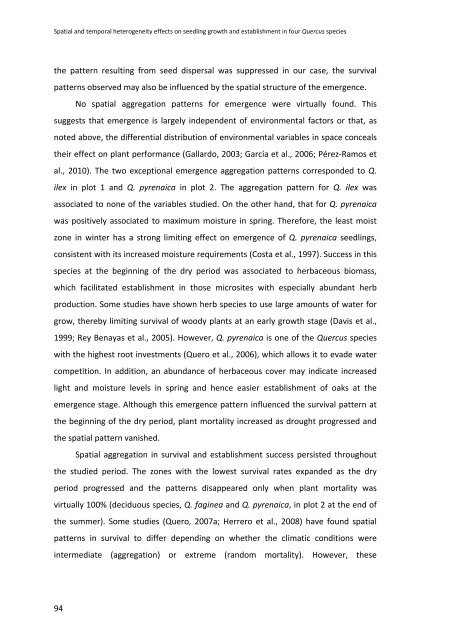Establecimiento de cuatro especies de Quercus en el sur de la ...
Establecimiento de cuatro especies de Quercus en el sur de la ...
Establecimiento de cuatro especies de Quercus en el sur de la ...
Create successful ePaper yourself
Turn your PDF publications into a flip-book with our unique Google optimized e-Paper software.
Spatial and temporal heterog<strong>en</strong>eity effects on seedling growth and establishm<strong>en</strong>t in four <strong>Quercus</strong> species<br />
the pattern resulting from seed dispersal was suppressed in our case, the <strong>sur</strong>vival<br />
patterns observed may also be influ<strong>en</strong>ced by the spatial structure of the emerg<strong>en</strong>ce.<br />
No spatial aggregation patterns for emerg<strong>en</strong>ce were virtually found. This<br />
suggests that emerg<strong>en</strong>ce is <strong>la</strong>rg<strong>el</strong>y in<strong>de</strong>p<strong>en</strong><strong>de</strong>nt of <strong>en</strong>vironm<strong>en</strong>tal factors or that, as<br />
noted above, the differ<strong>en</strong>tial distribution of <strong>en</strong>vironm<strong>en</strong>tal variables in space conceals<br />
their effect on p<strong>la</strong>nt performance (Gal<strong>la</strong>rdo, 2003; García et al., 2006; Pérez‐Ramos et<br />
al., 2010). The two exceptional emerg<strong>en</strong>ce aggregation patterns correspon<strong>de</strong>d to Q.<br />
ilex in plot 1 and Q. pyr<strong>en</strong>aica in plot 2. The aggregation pattern for Q. ilex was<br />
associated to none of the variables studied. On the other hand, that for Q. pyr<strong>en</strong>aica<br />
was positiv<strong>el</strong>y associated to maximum moisture in spring. Therefore, the least moist<br />
zone in winter has a strong limiting effect on emerg<strong>en</strong>ce of Q. pyr<strong>en</strong>aica seedlings,<br />
consist<strong>en</strong>t with its increased moisture requirem<strong>en</strong>ts (Costa et al., 1997). Success in this<br />
species at the beginning of the dry period was associated to herbaceous biomass,<br />
which facilitated establishm<strong>en</strong>t in those microsites with especially abundant herb<br />
production. Some studies have shown herb species to use <strong>la</strong>rge amounts of water for<br />
grow, thereby limiting <strong>sur</strong>vival of woody p<strong>la</strong>nts at an early growth stage (Davis et al.,<br />
1999; Rey B<strong>en</strong>ayas et al., 2005). However, Q. pyr<strong>en</strong>aica is one of the <strong>Quercus</strong> species<br />
with the highest root investm<strong>en</strong>ts (Quero et al., 2006), which allows it to eva<strong>de</strong> water<br />
competition. In addition, an abundance of herbaceous cover may indicate increased<br />
light and moisture lev<strong>el</strong>s in spring and h<strong>en</strong>ce easier establishm<strong>en</strong>t of oaks at the<br />
emerg<strong>en</strong>ce stage. Although this emerg<strong>en</strong>ce pattern influ<strong>en</strong>ced the <strong>sur</strong>vival pattern at<br />
the beginning of the dry period, p<strong>la</strong>nt mortality increased as drought progressed and<br />
the spatial pattern vanished.<br />
Spatial aggregation in <strong>sur</strong>vival and establishm<strong>en</strong>t success persisted throughout<br />
the studied period. The zones with the lowest <strong>sur</strong>vival rates expan<strong>de</strong>d as the dry<br />
period progressed and the patterns disappeared only wh<strong>en</strong> p<strong>la</strong>nt mortality was<br />
virtually 100% (<strong>de</strong>ciduous species, Q. faginea and Q. pyr<strong>en</strong>aica, in plot 2 at the <strong>en</strong>d of<br />
the summer). Some studies (Quero, 2007a; Herrero et al., 2008) have found spatial<br />
patterns in <strong>sur</strong>vival to differ <strong>de</strong>p<strong>en</strong>ding on whether the climatic conditions were<br />
intermediate (aggregation) or extreme (random mortality). However, these<br />
94

















